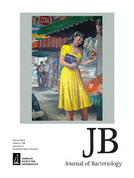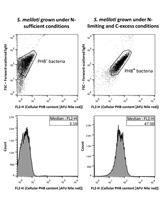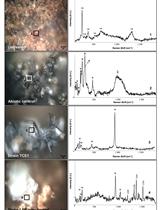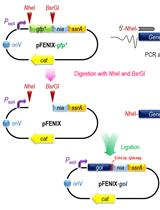- EN - English
- CN - 中文
Pyocyanin Extraction and Quantitative Analysis in Swarming Pseudomonas aeruginosa
群集铜绿假单胞菌中的绿脓菌素提取和定量分析
发布: 2016年12月05日第6卷第23期 DOI: 10.21769/BioProtoc.2042 浏览次数: 15937
评审: Valentine V TrotterAmit DeyAnonymous reviewer(s)
Abstract
This protocol describes the quantification of pyocyanin extracted from swarming colonies of Pseudomonas aeruginosa. Pyocyanin is a secondary metabolite and a major virulence factor, whose production is inducible and varies highly under different growth conditions. The protocol is based on the earlier developed chloroform/HCl extraction of pyocyanin from liquid cultures (Frank and Demoss, 1959). Swarming colonies together with the agar they occupy are split into two halves. Pyocyanin is extracted from one of them. Cells are collected from the other half and used to quantify total protein yield and normalize the estimated corresponding pyocyanin quantities.
Keywords: Pyocyanin (绿脓菌素)Background
Pyocyanin is a blue redox-active phenazine pigment produced by a human pathogen, P. aeruginosa. Pyocyanin is present in large quantities in the sputum of cystic fibrosis patients infected by P. aeruginosa (Wilson et al., 1988) and plays a major role in the virulence of the pathogen (Lau et al., 2004). Pyocyanin production is regulated by quorum sensing, which involves a cell-density-dependent synthesis of signal molecules that modulate the expression of virulence genes (Fuqua et al., 2001). Swarming is a complex communal behavior developing in response to multiple environmental signals and enabling cell motility on a semi-solid surface and colonization of host tissues. Our earlier observations suggested that pyocyanin production in liquid cultures of P. aeruginosa differ significantly from that in swarming colonies, likely due to quorum sensing regulation. Therefore, we developed a protocol allowing extraction and quantification of pyocyanin secreted by swarming cells into the surrounding agar. The obtained quantities are normalized by total cellular protein extracted from the swarming cells. This protocol differs from commonly used quantification of pyocyanin extracted from liquid cultures (Frank and Demoss, 1959) cells scrapped from a solid agar surface (De Vleesschauwer et al., 2006), or agar itself, but without normalization per total cell protein (Gallagher and Manoil, 2001). Normalized quantification of pyocyanin from swarming colonies allows studying the regulation of pyocyanin production and secretion during swarming, which is an essential component of P. aeruginosa adaptation to a host environment.
Materials and Reagents
- Glass test tubes (VWR, catalog number: 47729-578 )
- Razor blade
- Plastic storage containers and spatulas
- Glass scintillation vials (Thermo Fisher Scientific, Thermo ScientificTM, catalog number: B7999-6 )
- Glass Pasteur pipette
- 96-well flat bottom plates (Greiner Bio One, catalog number: 655-101 )
- 50 ml Falcon tubes (VWR, catalog number: 89039-658 )
- Whatman filter paper No.1 (GE Healthcare, catalog number: 1001-090 )
- 50 ml centrifuge vials
- 1.5 ml microcentrifuge tubes
- 0.2 μm filter
- 10 ml syringes
- PFTE lined caps for glass vials (Thermo Fisher Scientific, Thermo ScientificTM, catalog number: B7815-24 )
- Pseudomonas aeruginosa PAO1
- Chloroform (Pharmco-AAPER, catalog number: 3090000DIS )
- HCl (Pharmco-AAPER, catalog number: 284000ACS )
- Sodium hydroxide (NaOH) (Thermo Fisher Scientific, Fischer Scientific, catalog number: 1310-73-2 )
- Bradford reagent (Alfa Aesar, catalog number: J61522-AP )
- Bovine serum albumin (BSA) (Akron Biotech, catalog number: AK8917-1000 )
- Monosodium glutamate (Sigma-Aldrich, catalog number: 1446600 )
- Glycerol (Thermo Fisher Scientific, Fisher Scientific, catalog number: G33 )
- Sodium phosphate monobasic dihydrate (NaH2PO4) (Sigma-Aldrich, catalog number: 71500 )
- Potassium phosphate dibasic (K2HPO4) (Sigma-Aldrich, catalog number: 17835 )
- Sodium chloride (NaCl) (Sigma-Aldrich, catalog number: S7653 or VWR, catalog number: E529-500ML )
- Biotin (Gold Bio, catalog number: B-950-1 )
- Thiamine HCl (Gold Bio, catalog number: T-260-25 )
- Copper(II) sulfate pentahydrate (CuSO4·5H2O) (Sigma-Aldrich, catalog number: 209198 )
- Zinc sulfate heptahydrate (ZnSO4·7H2O) (Sigma-Aldrich, catalog number: Z0251 )
- Iron(II) sulfate heptahydrate (FeSO4·7H2O) (Sigma-Aldrich, catalog number: 215422 )
- Manganese(II) chloride tetrahydrate (MnCl2·4H2O) (Avantor Performance Materials, J.T. Baker, catalog number: 2540-04 )
- Yeast extract (BD, Bacto, catalog number: 212750 )
- Tryptone (BD, Bacto, catalog number: 211705 )
- Agar (BD, Bacto, catalog number: 214010 )
- Glucose (Alfa Aesar, catalog number: A16828 )
- Casamino acids (Teknova, catalog number: C2000 )
- Magnesium sulfate heptahydrate (MgSO4·7H2O) (Sigma-Aldrich, catalog number: 230391 )
- Biofilm mineral medium (BMM) (see Recipes)
- 10x basal salt solution
- Vitamin solution
- Trace metals solution
- Luria Bertani (LB) agar plates (see Recipes)
- Swarming agar plates (see Recipes)
- Potassium phosphate buffer
- 1 mM FeSO4
- 20 mM MgSO4
Equipment
- Potato masher (see Notes)
- BioMateTM 3 spectrophotometer (Thermo Fisher Scientific, Thermo ScientificTM, catalog number: 335904P )
Note: This product has been discontinued. A similar model is BioMateTM 3S spectrophotometer (Thermo Fisher Scientific, Thermo ScientificTM, catalog number: 840208400 ). - MaxQ 4000 table top shake incubator (Thermo Fisher Scientific, Thermo ScientificTM, model: SHKA4000 )
- SynergyTM Mx 2 Multi-Mode plate reader (BioTek Instruments) with Gen5TM 2.05 PC software (BioTek Instruments)
- Fume hood
- Centrifuge (Thermo Fisher Scientific, Thermo ScientificTM, model: SorvallTM ST 40R ) with 50 ml bucket insert (Thermo Fisher Scientific, Thermo ScientificTM, catalog number: 75003674 )
- Water bath sonicator (Thomas Scientific, Branson®, catalog number: 1207K40 )
- Centrifuge (Thermo Fisher Scientific, Thermo ScientificTM, model: SorvallTM RC 6 Plus Centrifuge ) with rotor type (Thermo Fisher Scientific, Thermo ScientificTM, model: F13-14x50 cy )
- Centrifuge (Eppendorf, model: 5424 )
- Table top standard orbital shaker (VWR, model: 3500 )
- 1 L graduated cylinder
Procedure
文章信息
版权信息
© 2016 The Authors; exclusive licensee Bio-protocol LLC.
如何引用
King, M. M., Guragain, M., Sarkisova, S. A. and Patrauchan, M. A. (2016). Pyocyanin Extraction and Quantitative Analysis in Swarming Pseudomonas aeruginosa. Bio-protocol 6(23): e2042. DOI: 10.21769/BioProtoc.2042.
分类
微生物学 > 微生物新陈代谢 > 其它化合物
您对这篇实验方法有问题吗?
在此处发布您的问题,我们将邀请本文作者来回答。同时,我们会将您的问题发布到Bio-protocol Exchange,以便寻求社区成员的帮助。
提问指南
+ 问题描述
写下详细的问题描述,包括所有有助于他人回答您问题的信息(例如实验过程、条件和相关图像等)。
Share
Bluesky
X
Copy link















